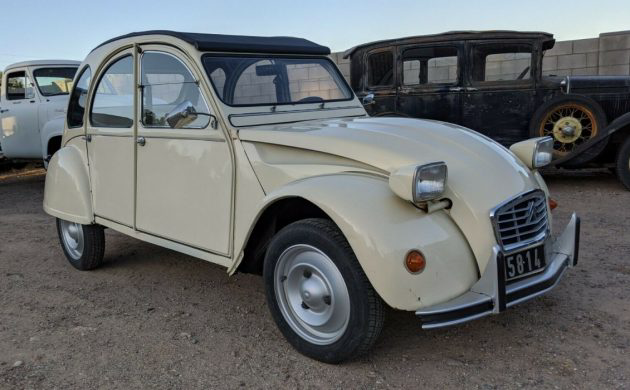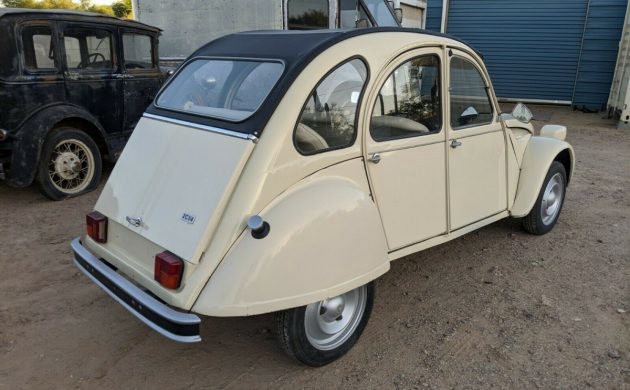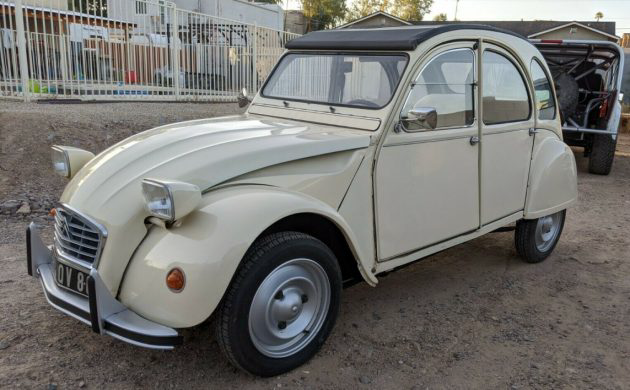Potential Bargain: 1976 Citroen 2CV
The owner of this 1976 Citroén 2CV must relocate for work, and as a result, he needs to part with this project car. It is a clean and tidy classic that runs and drives. All it needs is for a new owner to attend to a couple of small details, and the result should be a neat little car that is capable of providing years of motoring enjoyment. The 2CV is located in Phoenix, Arizona, and has been listed for sale here on eBay. The bidding has reached $6,655, and the reserve has been met.
The Citroén 2CV is what I would term as “an acquired taste.” These are a classic where some people love them, but others couldn’t care less about them. There doesn’t seem to be a middle-ground. This one appears to be in excellent condition for its age. The owner’s cause in the restoration was aided significantly by the fact that he commenced the project with a very sound vehicle. As you will see from this YouTube video, the Citroén looked tidy and clean the day that he collected it. He was very fortunate because it does appear to be a rust-free car. The Nevada Beige paint was also in good condition for its age, and he has done little more than to block and buff the paint to achieve the high shine that you see today. It isn’t perfect, because it does have a few marks and cracks. However, as a survivor-grade classic, I don’t see anything wrong with leaving it as-is. The original top had a few issues and some damage, so a new top has recently been fitted. Beyond that, the trim and chrome appear to be good, while the glass is also in good condition.
In 1975, a factory remanufactured 602cc engine was installed, which produces 36hp. This power gets to the front wheels via a 4-speed manual transmission. When the owner purchased the Citroén, it wasn’t running. It was afflicted with an electrical gremlin, which is now fixed. The engine compression was checked, and it has returned good readings. There were also a few problems with how well the engine ran, so it has been treated to new fuel lines, along with a new carburetor, sending unit, and fuel pickup. Completing the mechanical refurbishment, the vehicle sports electronic ignition, new plugs, plug wires, and a fresh coil. The Citroén runs and drives well, but the idle is inconsistent. It is believed that there is an air leak on the intake, and the next owner will need to address this if that little engine is to run perfectly.
Life inside a 2CV represents motoring at its most basic. There are no luxury items or appointments, and it is a case of what you see is what you get. Having said that, the interior of this Citroén has been nicely refurbished. The seats feature custom covers in plaid cloth and beige vinyl. The door trims have been replaced, and there are new rubber mats on the floors. It presents well and is one area where the buyer won’t have to consider spending one red cent. One of the interesting characteristics of the 2CV is the fact that the seats feature minimal padding. However, that doesn’t make it an uncomfortable vehicle to travel in. Thanks to soft and compliant suspension, many of the bumps and lumps in the road are absorbed before they can find their way inside the cabin. It all feels slightly odd initially, but it doesn’t take long to become used to the sensation.
One of the aspects that makes the classic car scene so interesting is the sheer variety of machinery that it throws up for enthusiasts. There will be readers who will dismiss the Citroén 2CV out of hand, while there will also be a lot of readers who will find this car to be an attractive proposition. I quite like these little French classics because they are so quirky. They are also not a car that should be dismissed lightly because you will struggle to find good examples for sale today below $15,000. In fact, sale prices over $20,000 are quite commonplace. This Citroén holds a wealth of promise, and the reserve has been met at its current bid price. That means that there is the possibility that someone is about to buy a 2CV at a very competitive price.
Auctions Ending Soon
 1965 Ford Falcon Station WagonBid Now2 days$2,300
1965 Ford Falcon Station WagonBid Now2 days$2,300
 2002 Jaguar XK8 ConvertibleBid Now3 days$4,250
2002 Jaguar XK8 ConvertibleBid Now3 days$4,250
 1979 Chevrolet Camaro Z/28Bid Now4 days$4,500
1979 Chevrolet Camaro Z/28Bid Now4 days$4,500
 1960 Dodge D300Bid Now4 days$300
1960 Dodge D300Bid Now4 days$300
 2006 Ford Mustang Saleen S281 SCBid Now6 days$100
2006 Ford Mustang Saleen S281 SCBid Now6 days$100






Comments
The 2CV has long been one of THE worst built vehicles of any kind in an accident. It has door handles because the thing doubles as your coffin after a wreck.
Unsafe at any speed ?
Just cruise the net for photos of these in bad wrecks. I guarantee you the driver seldom lives. These things fold up like your daughter’s lemonade stand.
One has to understand the whole point of the 2CV in its history. I beg to update you Will Fox – I don’t know how old you are, but this car put France on wheels after WW II, which I’m sure you never experienced. Their industry was trashed by the Germans, and France still doesn’t have a real source of liquid gold – OIL – they smartly invested in reliable, trouble-free nuclear plants that make 80% of France’s energy – I keep trying to understand why we in the US can’t do that.
So after the war, they needed transportation, as cheap as possible, and as fuel efficient as possible. That’s the whole point of this milestone car.
The roads in France were also terrible – probably due to bomb craters everywhere. The 2CV was actually initiated around 1938 – the end of the ’29 depression and beginning of hostilities in Europe. When the car started production around ’46 or thereabouts, it was designed specifically to put farmers on wheels, and designed to cross a ploughed field, with a basketful of fresh eggs in the back, without breaking an egg. Try that in any other car in the world and you end up with a scrambled MESS. But the 2CV could do that. Back then it also got about 50 or more MPG, having only around 12 HP. But it was improved later to 29-32. And 40 continuous years of production is a record I don’t think any other car can match except maybe VW, and that brand changed a great deal vs the 2CV
Another bit of info: The car wasn’t built to be a bad car, it was built as super cheap transportation to rebuild France – don’t forget that. And it did that job better than any other mode of transportation of the time. You claim it’s one of the worst cars ever built – then why does it have one of the most sophisticated and expensive suspensions vs any other car built today?
I’m sure very few people have ever looked closely at the build of the 2CV, but I have been thru every nut/bolt/part of them. For example – do any of your cars or anyone else’s beyond Citroens have every suspension arm mounted NOT in cheap rubber bushings, but TAPERED ROLLERBEARINGS? And why of all things did they do that?? Rollerbeariings are far more expensive than rubber bushings. But those bearings are what make the truly wacky but ingenious suspension of this car able to go darn near anywhere without 4WD – the suspension travel is so great and capable that I’ve driven over 8 inch thick freestanding RAILROAD TIES with 3 people in a 2CV and barely felt those huge ties! Rubber bushings could never do that – they’d be torn to pieces trying to rotate that much in a couple miles of travel. You don’t need 4WD with a 2cv – they’ll go nearly anywhere, and if you get stuck, two people can lift the back end out of a rut and swing the car around – it’s that light. Same thing re rollerbearings for the Citroen DS hydropneumatically suspended car with the most comfortable suspension ever designed – huge suspension travel and nitrogen gas springs instead of steel – works wonders for comfort.
The body is only one thin steel panel everywhere, but that’s due to the fact that steel after the war was in short supply, and that kept weight down and gas mileage UP, when gas was very expensive and still is in Europe – TWICE our cost/gal.
Not only all this, but I’m guessing that more 2CVs have driven around the world, in every country, than any other vehicle – because they’re designed for extreme reliability and simplicity. They’re not perfect by any means, especially when compared to modern cars, but they work for their designed purpose, and they are quite comfortable inside, and even better – they’re not just a car, they’re an EVENT to most outsiders – they attract attention wherever they go – they are an icon in the auto world – especiially outside the US, as they’ve been everywhere and still are out there after 70 years. Remember their original purpose – helping to rebuild France.
Very well said-and clearly written. 2cvs are just amazing cars and have a dedicated and large following in Europe
It’s ugly, French, and has a lawn tractor engine in it. No amount of polishing can de-turd it.
I can see where people who don’t understand French cars would be turned off. Then, again, I think fox bodied Mustangs are stupid. C’est la vie!
Great chick magnet !!
Roger Moor out maneuvers the bad guys in a 2CV !!
https://www.youtube.com/watch?v=A8fejSDxYII
matt
The cameras can make Roger Moore out-maneuver the bad guys, even today!
Super fun to drive and own. Nay sayers usually have only read about them but never spent any time behind the wheel! This one claims 36hp! My gawd, it’s a hot rod! Standard is 29hp, so this ones extra 7 ponies must rip the tires loose!
standard is 24 hp, this engine can last for ever, this is the most fun car to drive, drive it and you will love it, safe, unbelievable road holding , brakes very well,very comfortable and very low fuel consumption. probably the best car ever mass produced.
I drove one back and forth to work in rural Massachusetts in the 1970’s. A cop once pulled me over just to ask me what the heck it WAS.
French cars are an acquired taste, like snails or pate. However, those of us who enjoy them LOVE them! And this one is a gem! Vive la France!
There are two types of people, those that love these little cars, and those that haven’t driven one.
I’ve driven a 2CV across the USA twice — loved it and lived to tell about it:
https://citroenvie.com/roland-voegeles-and-george-dykes-july-2105-tour-of-the-usa-western-canada/ and
https://citroenvie.com/george-dyke-roland-voegeles-2cv-usa-trip-may-2011/
Can i bring her home?
This is actually a Dyane, the 2CV’s upscale version, so even better for the price!
One has to understand the whole point of the 2CV in its history. to understand its design and construction. This car put France on wheels after WW II, Their industry was trashed by the Germans, and France still doesn’t have a real source of liquid gold – OIL – they smartly invested early in reliable, trouble-free nuclear plants that make 80% of France’s energy – I keep trying to understand why we in the US can’t do that.
So after the war, they needed transportation, as cheap as possible, and as fuel efficient as possible. That’s the whole point of this milestone car.
The roads in France were also terrible – probably due to bomb craters everywhere. The 2CV was actually initiated around 1938 – the end of the ’29 depression and beginning of hostilities in Europe. When the car started production around ’46 or thereabouts, it was designed specifically to put farmers on wheels, and designed to cross a ploughed field, with a basketful of fresh eggs in the back, without breaking an egg. Try that in any other car in the world and you end up with a scrambled MESS. But the 2CV could do that. Back then it also got about 50 or more MPG, having only around 12 HP. But it was improved later to 29-32. And 40 continuous years of production is a record I don’t think any other car can match except maybe VW, and that brand changed a great deal vs the 2CV
Another bit of info: The car wasn’t built to be a bad car, it was built as super cheap transportation to rebuild France And it did that job better than any other mode of transportation at the time. When it is compared with cars that were built 10 yrs after the introduction of the 2CV, it appears to be one of the worst cars ever built, yet it has a much more sophisticated and expensive suspension than many other cars built today. I’m sure very few people have ever looked closely at the build of the 2CV, but I have been thru every nut/bolt/part of them. For example – does anyone else’s product other than Citroens have every suspension arm mounted NOT in cheap rubber bushings, but TAPERED ROLLERBEARINGS? And why of all things did they do that?? Rollerbeariings are far more expensive than rubber bushings. But those bearings are what make the truly wacky but ingenious suspension of this car able to go darn near anywhere without 4WD – the suspension travel is so great and capable that I’ve driven over 8 inch thick freestanding RAILROAD TIES with 3 people in a 2CV and barely felt those huge ties! Rubber bushings could never do that – they’d be torn to pieces trying to rotate that much in a couple miles of travel. You don’t need 4WD with a 2cv – they’ll go nearly anywhere, and if you get stuck, two people can lift the back end out of a rut and swing the car around – it’s that light. Same thing re rollerbearings for the Citroen DS hydropneumatically suspended car with the most comfortable suspension ever designed – huge suspension travel and nitrogen gas springs instead of steel – works wonders for comfort.
The body is only one thin steel panel everywhere, but that’s due to the fact that steel after the war was in short supply, and that kept weight down and gas mileage UP, when gas was very expensive and still is in Europe – TWICE our cost/gal.
Not only all this, but I’m guessing that more 2CVs have driven around the world, in every country, than any other vehicle – because they were designed for extreme reliability and simplicity. One reason they’re so reliable an engine is due to something I learned only recently while reading one of their factory repair maunals: The 2cv engine is the only engine I know of, and I’ve seen a ton of them on the inside, is that the exhaust valve guides have a groove machined into the outside of them which allows an oil passage drilled into the cylinder heads to feed crankcase oil around the valve guide to suck heat out of the that hottest valve in the engine. With that extra small bit of cooling that no other engine seems to have, the engine can be run flat out all day long without burning a valve in spite of how hot it may be in the local climate.
They’re not perfect by any means, especially when compared to modern cars, but they work for their designed purposes, they are quite comfortable inside, and even better – they’re not just a car, they’re an EVENT to most outsiders – they attract attention wherever they go – they are an icon in the auto world – especiially outside the US, as they’ve been everywhere and still are out there after 70 years. Their original purpose was admirable and successful they helped rebuild France.